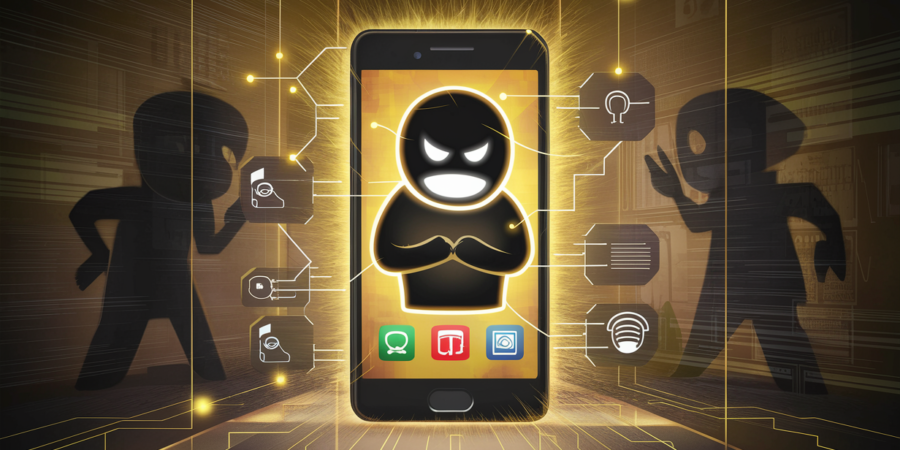Introduction: One Wrong Download Can Open the Door to a Cyberattack
Imagine this: A 17-year-old student in Surat downloads a “free study booster” app from a Telegram group. It promises better focus, free notes, and AI tools. Within hours, his camera switches on without permission. By the next morning, his private photos are leaked, and his Instagram is hacked.
Or take the case of a homemaker who installs a fake fitness tracker sent via WhatsApp. The app silently accesses her UPI account, empties her digital wallet, and sends scam messages to her entire contact list.
These are not just stories. They’re real-life cases we’ve dealt with at Cybersense. And they all started with just one tap — on a fake app.
In today’s world, where mobile apps handle everything from learning to banking, one wrong download can steal your identity, spy on your life, or ruin your mental peace.
That’s why this blog isn’t just a tech checklist — it’s a digital survival guide for students, parents, and everyday users in 2025.
What Is a Fake App?
A fake app looks like a regular app but is secretly built to:
- Steal your personal data (contacts, photos, messages)
- Spy through your camera or microphone
- Record your screen without consent
- Hack your payment apps or digital wallet
- Send malware or scam links from your device
These apps often appear as:
- Free AI tools, games, photo editors, exam boosters
- Modded versions of famous apps (like GB WhatsApp, WhatsApp Pro)
- Clone apps pretending to be Paytm, SBI, Digilocker, etc.
And the most dangerous part? They look real. Until it’s too late.
Why Students and Parents Are the Biggest Targets
Students love new apps: AI bots, wallpapers, photo editors, productivity tools. But many don’t verify app sources.
Parents trust what is forwarded in groups — like health, shopping, or loan apps. Many don’t read permission requests.
Cybercriminals know this. So they target you — not with force, but with temptation.
How to Spot a Fake App Before It Spies on You
1. Check the Developer — Not Just the App Name
Many fake apps copy the names of popular apps like Paytm, Instagram, or IRCTC. But check the developer name listed below the app title.
Example:
Real: “Paytm – One97 Communications Ltd.”
Fake: “Paytm UPI by TechWorld Softwares”
If the developer name feels off or unknown, avoid downloading it.
2. Read the Negative Reviews — Not Just the 5-Star Ones
Fake apps often pay for fake 5-star ratings. But negative reviews reveal the truth.
Look out for reviews that say things like:
- “Too many ads”
- “Phone hangs after installing”
- “App opens and crashes”
- “My data got leaked”
If even 5% of users are raising red flags, don’t ignore them.
3. Observe the Icon and Spelling Closely
Cybercriminals often use visually similar icons or names that are slightly misspelled, hoping you won’t notice.
Real vs Fake Examples:
WhatsApp vs WhatssApp
Snap Chat vs SnapCat
Instagram AI vs Instagramee Pro
Tip: Compare the app’s logo, size, and description with the official version on a trusted app store.
4. Look at the Permissions It Asks For
Why would a flashlight app need access to your microphone and contact list?
Why would a game need permission to your camera and location?
Always ask: “Does this permission make sense for what the app does?”
If not, deny it or uninstall the app immediately.
5. Avoid Downloading Apps Shared via WhatsApp, Telegram, or YouTube Links
This is the #1 way fake apps spread — forwarded links promising:
- Free games
- Hacked Netflix accounts
- Custom exam tools
- Premium Instagram followers
These are not apps. They are traps.
Only download apps from:
- Google Play Store (Android)
- Apple App Store (iOS)
- Official websites
Never install APK files unless you’re 100% sure of the source.
6. Check the Number of Downloads & Last Update Date
Trusted apps have millions of downloads
Fake apps often have less than 10K or 100K installs
Real apps get updated regularly
Fake apps are often abandoned after being flagged
Combine all clues before clicking “Install.”
Real Case Study from Cybersense Files
Case: “Voice Access App” Trap in a Surat Coaching Institute
A group of students installed a trending app from a Telegram channel that claimed to boost voice typing for notes.
It had a 4.9-star rating and looked professional. But once installed, it secretly accessed:
- Mic (recorded live conversations)
- Camera (captured images)
- Contacts (sent phishing messages from their phones)
One student was blackmailed with personal audio recordings. Two others had their Instagram accounts hijacked.
This case is now part of our mobile safety training workshop for schools.
Warning Signs You Already Have a Spy App Installed
- Phone suddenly becomes slow or overheats
- Ads appear on lock screen or home page
- Data usage increases unexpectedly
- You see apps or icons you never installed
- Battery drains faster than usual
If you notice these signs:
- Uninstall the suspicious app immediately
- Run a full antivirus scan (Norton, Avast, Bitdefender, etc.)
- Change passwords for all social and banking apps
- Report the app to Google or Apple
Final Thoughts: Every App You Install Is an Entry into Your Life
Your mobile is your bank, your memory box, your camera, your ID, your social circle — all in one.
So, would you let a stranger have full access to all of that?
That’s what fake apps do. They enter quietly and take everything — data, dignity, and control.
At Cybersense, we don’t just warn you — we equip you.
We believe every student and every parent must learn digital hygiene — just like personal hygiene.
Cybersense Offers:
- Mobile Safety Workshops for Schools & Colleges
- Scam Simulation Activities for Teens
- Parental Guidance Programs on Safe App Usage
- Cyber Hygiene Curriculum for Institutions
Visit Cybersense : Website | Instagram | LinkedIn | Facebook

